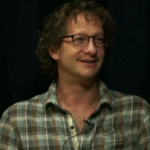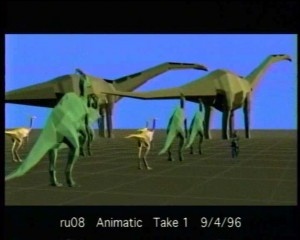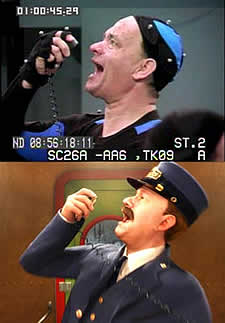The Work of Film Through Technology: Interview with CG Supervisor Morris May
 Morris May is a computer graphics (CG) film big wig—or at least he was. It is not that Morris is no longer a ‘big wig’ or even an FX supervisor credit for that matter, but rather he splits building ‘ 3D nebulas’ for Reliance Films with surfing. He is not the average computer nerd, one might say.
Morris May is a computer graphics (CG) film big wig—or at least he was. It is not that Morris is no longer a ‘big wig’ or even an FX supervisor credit for that matter, but rather he splits building ‘ 3D nebulas’ for Reliance Films with surfing. He is not the average computer nerd, one might say.
Despite the fact that he can create things on Autodesk’s Maya that their own software designers may have never have dreamed up (or more accurately, that only a few people on this Earth can), being a ‘big wig’ was never May’s intention. As a CG Supervisor at Hydraulx, Morris led CG on blockbuster hits, 2012, X-Men Wolverine, Fast & the Furious, Bedtime Stories, and Australia. He lived in the actual country of Australia for two years leading Happy Feet, which won an Academy Award for Best Animated Film, has an MTV music award from earlier in his career for a Garbage video, and worked on Spiderman 2, which again won an Academy Award for Best Visual Effects. We could say his resume is thick and growing thicker, despite his distaste for offices; lunch carts, cheese platters, and the moments at 3 a.m. snooping office kitchen cabinets finding nothing but stale saltine crackers to tide him over while rendering on 60 hard drives.
“I would do it for free,” Morris tells me of his love for building CG film. Although, his vast knowledge and expertise is a day and evening activity when he is not in the afternoon wind on a kitesurf board in Malibu (explaining his not so nerdy tan).
I caught up with Morris over an afternoon surf at a secret spot up in Malibu to learn just how a CG film is made. To those of us far removed, it is a vast and intricate assembly line of departments resembling that of Henry Ford’s. I have heard it once described as a series of miracles. To Morris, it is a carefully calculated and crafted series of steps, executed by the smartest people he knows. And believe me, these people are smart.
First Take CG Sup Reel from Morris May
The story department
Every film starts with a script; CG, live action, student short, the script is the bed frame. In CG, the script is a working tool, adjustments are more easily ‘rendered’ in for a CG film, therefore the script floats more than live-action.
“I have worked on CG films where the script was re-written half way through production several times,” explains May. Something we would never see in the world of live action without blowing budgets vastly out of proportion. Although, you always have to start somewhere, so the script kicks us off.
Casting actors is the second step to CG (sometimes similar to live action but usually only if ‘a name’ needs to be attached to sell a script, an actor may be cast beforehand). With animated and computer generated characters we don’t often associate casting as an integral beginning step, as the characters the actors are playing are not even formed. Yet, actors remain a main part to character development (based on personality), as well as the ‘performance’ of the film.
Actors are brought in, from the beginning, to record voice in studio. Such actors might have even undergone some kind of voice over training to improve their voice quality. The new CG films even take it one step further, in that they videotape actors while recording scenes. “We record to catch certain nuances of that actor,” says May. “One of my favorite examples of this would be Robbin Williams as the CG animated genie in Aladdin,” exclaims Morris excitedly.
With this new development, we often think of the dramatic roles of Gollum in Lord of the Rings and Caesar in this year’s release, Planet of the Apes: Rise of the Apes, played by Andy Serkins. Serkins was video recorded for both roles on top of motion capture in order to create a CG character with human-like depth in facial expressions and emotions. This is a technological innovation of the past decade and perhaps the most extreme case of using the actors ‘nuances.’
With this example, May went on to stress the difference between live-action and CG in recording actors, as scenes in CG are recorded solo. Interaction is removed (often), making it easier to record snippets and pieces to animate to as the scenes evolve through the on-going writing and production of the film. “Actors love doing CG as they can come to a studio in their pajamas, record for a few days, and work on other projects,” with just a few rounds of additions and adjustments, says May. CG is a great gig for actors, to say the least.
Once actors are recorded, we move to ‘boardomatic.’ “Boardomatic is a story board (drawn characters and scenes, frame-by-frame) of the entire film from beginning to end. It is the length of the film with actors dialogue placed on top of a series of stills that are drawn” of the characters, settings, etc, as explained by May. Then comes ‘animatic.’
Animatic is rough animation to get timing and the look of the characters, once in digital, down. The entire film is created in rough animation based on each storyboard frame.
Lastly, comes the CG nitty-gritty and building to perfection of all the in between; character emotions, special effects, environment changes, setting, etc. Once the framework is set, it is about putting all the departments in motion to bring a cohesive picture to life.
The Breakdown Behind CG
Production in CG always begins with the art department and the style guide (photos and drawings showing the look of the film used as inspiration for the art department to create “the look”). A style guide will dictate color scheme, mood, feel, etc.
Character design is thus begun by the modeling department, with permission from the art department. Characters are each molded out of clay for a 3d animation look. This is done so that the animators can see what each character looks like from every angle. The modeling department designs “characters, sets, props—wire frame is thus created by use of the clay models,” which will be animated by May.
Once the models are built, ‘character rigging’ takes place. “We place a skeleton inside the model (the bones) [on the computer], as this is what will be animated,” says May. “Face shapes and movement all come from this structure like in a real person. Controls to animate character come from rigging, where we can blend shapes, for example, carving the phonemes of speech (a, e, i, o, u).” Once you have the phonemes, these can be combined to create speech in full and “make basic expressions; surprised, shocked—the tools to bring characters to life!”
Simultaneously, The Texturing department works side-by-side creating “a 2D texture map of the characters, i.e., skin tone, clothes, hair, and eye (done by specialists for each attribute).” This will be layered on top of the fire framing (bone structure).
 In today’s CG animation, rather than distorting the exterior, rigging allows the animator to rebuild the exterior. “When you smile, skin moves over muscles to form it, your face does not distort, skin rather forms over bones to make coherent motions,” says May. In CG, this fluid movement is the main goal in creating realism within each shot and character expression. Therefore, rigging is a very important step in how animators will later control characters when animating.
In today’s CG animation, rather than distorting the exterior, rigging allows the animator to rebuild the exterior. “When you smile, skin moves over muscles to form it, your face does not distort, skin rather forms over bones to make coherent motions,” says May. In CG, this fluid movement is the main goal in creating realism within each shot and character expression. Therefore, rigging is a very important step in how animators will later control characters when animating.
As the CG film moves into the stage of animation, there becomes two methodologies. We begin with key frame animation. This is the “Pixar and cartoony” look, according to May; in which case, everything is done by hand. This method is much more time consuming. It mimics stop-motion. “A great example of this type of animation is the original Jurassic Park,” laughs May, as this is not his preferred form of animating. “The armature of characters is based on a motor that would capture it in space and time and the animators would move it from there.”
 The second type, is motion capture. Like our example earlier of Gollum and Caesar of Planet of the Apes, this method uses an actor in a suit moving through scenes while data of this motion is fed into a computer. Examples of this type of animation are seen in Polar Express, Happy Feet (both films in which May worked on) and Mars Needs Women. Motion capture is often remembered by the ball covered suits that actors wear.
The second type, is motion capture. Like our example earlier of Gollum and Caesar of Planet of the Apes, this method uses an actor in a suit moving through scenes while data of this motion is fed into a computer. Examples of this type of animation are seen in Polar Express, Happy Feet (both films in which May worked on) and Mars Needs Women. Motion capture is often remembered by the ball covered suits that actors wear.
In this suit, each ball is magnetic and optical; surrounded by infrared cameras. The balls create “point tracking data,” which tell us where each ball is in 3D space. According to May, “this is then used to triangulate point cloud data to tell you where each ball is, as strategically placed for inverse kinematics.” Inverse kinematics gives us a guide to “locations of joints for building the characters in CG,” elaborates May. (May goes on to tell me a spine tingling story of how he suggested drilling a hole in Tony Hawk’s elbow during the creation of Pro Skater which used GT Accessories for protection, as this way there would be no distortion in movement created by the fabric of a suit—a true CG animator with a one track mind)
For facial capture, a series of points is drawn on a face of an actor that drives the skin to capture actor’s expressions (once again, our Planet of the Apes and Lord of the Rings example). “Motion capture is used in facial expression as well,” May dictates, “you always have to reanimate, but it is a great reference point.”
May is clearly a much larger fan of the motion capture method of animating, by the tone of his voice. He explains that key framing is a much longer and time consuming process, which takes editing again-and-again, according to the directors reviews. May, further explains why by telling me that with “motion capture, a director can direct in real-time” while watching actors move in motion capture suits in front of him. This allows motions to be adapted on the spot, rather than after the fact. It literally gives the director freedom to direct the actor on the spot, rather than correct in post-production. This is something that can save a film a lot of money.
The Department Breakdowns, According to Morris May
When Henry Ford created the assembly line, he knew that mechanized creation was the sum of many moving parts placed in a specific order. The movie business is no different. Each department acts as a cog in the larger moving whole of the machine. I again reiterate the quote once told to me of the series of consecutive miracles that lead to film creation.
The basic departments of a CG film can be broken into two. Story and production. In story, we have boardomatic, animatic, look development, and pre-visualization. Each of these departments prepare the story to be told in a certain way. We covered all above, except pre-visualization which is roughly blocking out of a scene (camera angles, etc.)
In production, the basic breakdown is: modeling, animation, lighting, look development, simulation, effects, character effects, crowd, and texturing.
As a CG supervisor, May oversees everything. Although his passion lies within effects and animation. In effects, May works with particle driven scenes: explosions, snow, water, any kind non-character movement. The job of the effects department is to simulate everything that happens in the film. They are removed from the animation team.
Demo Reel from Morris May
Unlike effects, a department like lighting is directly connected to every department. This team of people develops how light behaves in each scene which effects the way we see characters, sets, as well as effects simulations. Is the light source from the sun (meaning the set and characters are outside)? How does light bounce off objects within the scene? This department has been fluttered with new technologies as it plays an all encompassing role in the film.
“Newer films use radiosity, which shows how light behaves when bouncing,” says May. May also mentions global illumination, which can be defined as photo realistic lighting. Just like in a live action Hollywood studio film, the lighting can define the entire look of the picture.
How to Create a CG Film: The Difference Between Computer Graphics and Live Action Hollywood
In computer graphics, the script is the floating bed frame of the film; meaning it is never final. It is rather an outlined structure. Dialogue is add-libbed in, manipulated, deleted, and so on. Due to the nature of the process, this allows for on-going change. In live-action, actors are always in scenes; meaning words and actions can not be changed after the fact. “The boardomatic is constantly manipulating [in CG],” says May on the process.
Because of the non-linear work flow in CG, it is easier to make these manipulations. The film is not bound to actor, scheduling or plates; but rather can adapt according to team adjustments. In CG film-making, you can stop and start all over again as many times as you want. The original Toy Story is a classic example of this, as it went through even a series of directors before completion. In a live action film, it would be almost impossible to do this without starting from scratch.
Notably, a CG film is created by a committee of decision makers. In live action film, the editor has a lot of control as you are dealing with plates that are locked in timing, as well as multiple actors. CG actors are recorded alone, allowing for so much manipulation that having a group of decision makers can give the film a nice touch. In CG, it is rare to look at dailies (scenes from the day’s work) alone, where in live action decisions come down to the director as top authority.
The differences also explain why a CG film may take much longer to complete. Once again, I bring up the original Toy Story, as it took about 4 years to complete. Morris May, continues work on a film that has been in production for almost five years, with another one to two years predicted longer in workload. To May, the process is so intricate and complex that it seems very normal to work on a project for a long period of time. Like a business, there needs to be several elements to lead to successful creation. In live-action, strict scheduling and limitations lead to a much shorter production period. Back to the world of CG, on average, it can take three to six years from original concept to end with thousands of people working on it. I even asked May: if a CG film was created by one man, how long would it take? He responded, “a lifetime.”








